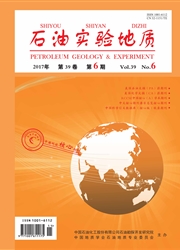

 中文摘要:
中文摘要:
通过对大量钻井资料的综合分析.详细讨论了塔里木盆地巴楚地区石炭纪地层存在的主要问题。建立了该区两统4组新的地层层序,恢复了巴楚组与卡拉沙依组的原定义,新建玛扎塔格组。确认“巴楚运动”发生在早石炭世晚期,其在塔里木盆地表现为西强东弱。巴楚隆起东段砂泥岩段角度不整合于上泥岩段之上,西段为小海子组覆盖在中泥岩段或生屑灰岩段之上,至隆起西端——柯坪地区则为康克林组覆盖在四石厂组之上.巴楚组至玛扎塔格组剥蚀殆尽。巴楚隆起西部小海子组产Triticites带,发育逍遥阶,东部则缺失。建立了小海子组与南闸组的岩电划分标准,2组分别产ssuberectus—sparvus—Gbella带、Triticites带与sisolatus带、S.whitei-Npequopensis带、Pseudoschwagerina带:2组间的间断由东向西逐渐缩小,至巴楚隆起西端为整合接触关系。
 英文摘要:
英文摘要:
Based on the comprehensive analysis of drilling data, the Carboniferous stratigraphy of the Bachu uplift in the Tarim Basin was discussed. Four new stratigraphic sequences were found, the original definitions of the Ba- chu and Kalashayi Formations were restored, and the Mazatage Formation was established. It was confirmed that the Bachu Movement took place at the end of the Early Carboniferous, and the movement was severe in the west and weak in the east of the Tarim Basin. In the east of the Bachu uplift, sandstones and mudstones lay on the upper mudstones with an angle unconformity. In the west of the uplift, the Xiaohaizi Formation lay on the middle mud- stones or the bioclast limestones. From the west of the uplift to the Keping area, the Kangkelin Formation lay on the Sishichang Formation, and the Bachu and Mazatage Formations were eroded. Trit&ites belt and the strata of Xiao- yiaoan Stage developed in the Xiaohaizi Formation in the west of the Bachu uplift and disappeared in the east. A classification standard of lithologic and logging characteristics was founded between the Xiaohaizi Formation and the overlying Nanzha Formation of the Lower Permian. The S.suberectus-S. parvus-G, bella and Triticites belts de- veloped in the Xiaohaizi Formation while the S. isolatus, S. whitei-N, pequopertsis and Pseudoschwagerina belts developed in the Nanzha Formation. The discontinuity between the two formations gradually reduced from east to west in the Bachu uplift, and disappeared (with conformity) in the western edge of the uplift.
 同期刊论文项目
同期刊论文项目
 同项目期刊论文
同项目期刊论文
 期刊信息
期刊信息
